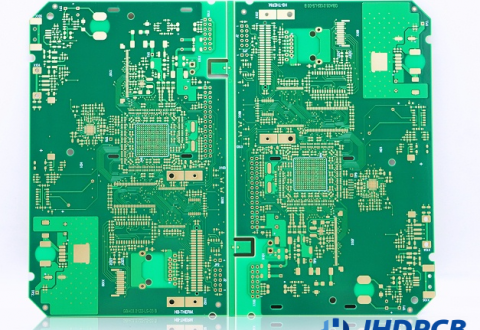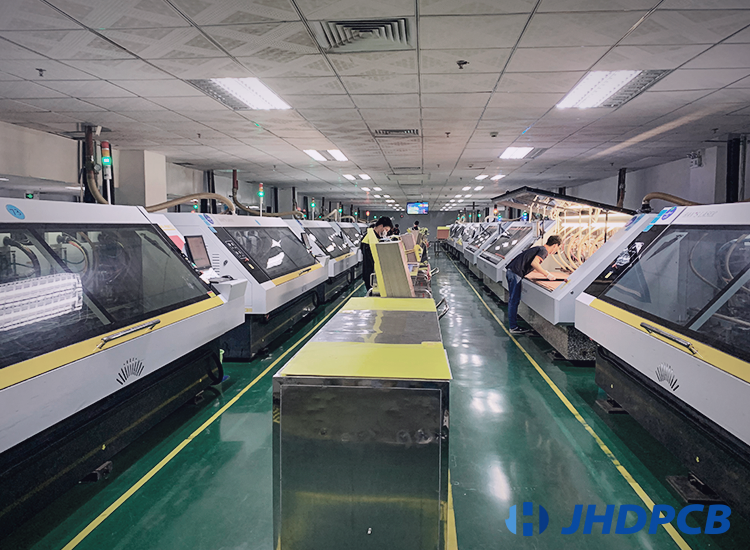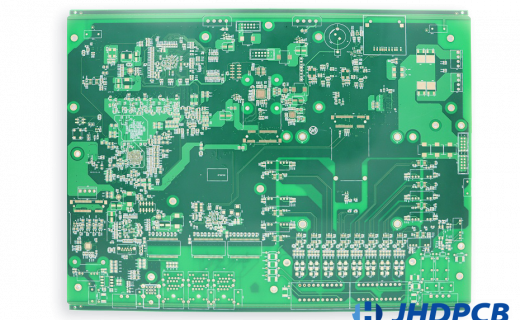High TG PCB
For printed circuit boards that are exposed to high thermal loads for a long period of time, the necessary long-term operating temperature must be determined as early as possible in order to select suitable materials.
The Tg value of the base material can be used as a reference. Below JHDPCB has summarized the details for you.
directory
High Tg PCB refers to glass transition temperature (Tg) is higher than 170 degrees Celsius.

What is High TG PCB?
In addition to basic FR-4 materials in PCB production, some projects need to use high TG materials, so what are high TG materials? High Tg is another name for a high-temperature PCB, meaning printed circuit boards designed to stand up to high-temperature extremes. A circuit board is defined as high Tg if its glass transition temperature (Tg) is higher than 170 degrees Celsius. The full name of TG used in PCB fabrication is glasstransitiontemperature, which stands for glass transition temperature. The Glass Transition Temperature (Tg) is one of the most important properties of any epoxy and is the temperature region where the polymer transitions from hard, glassy material to a soft, rubbery material. The circuit board must be flame-resistant, it cannot burn at a certain temperature, it can only soften. The temperature point at this time is called the glass transition temperature (Tg point), and this value is related to the dimensional stability of the PCB board. The higher the TG value, the better the temperature resistance of the PCB. When the temperature rises to a certain area with a high TgPCB, the substrate will change from a “glass state” to a “rubber state”, which is called the glass transition of the sheet (Tg). temperature.
FR-4 high Tg PCBs contain PCB material for high-temperature situations so you can count on them even under extreme temperature conditions. Typical PCB materials for high temperature may include Shengyi S1170, ITEQ IT-180, Rogers Theta 100 and many others.
For more details, see the JHD Copper Clad Laminate (CCL) database.
The larger the Tg of the substrate, the better the heat resistance, moisture resistance, chemical resistance and resistance stability of the circuit board will be enhanced and improved. The higher the TG value, the better the temperature and other properties of the board, especially in the lead-free manufacturing process, where there are more applications of high Tg. As usual, made with Tg ≥ 170℃ PCB material, which is called a high Tg printed circuit board.High TG PCB is a circuit board with a high glass transition temperature.
The higher Tg point means a higher temperature requirement during lamination. And the boards will be hard and crisp, which will affect the hole and the electrical properties.Ordinary PCB materials at high temperatures, not only will be softened, deformation, melting and other phenomena, but also the mechanical and electrical properties decline sharply. General FR4 Tg is 130-140 centigrade, moderate Tg is greater than 150-160 centigrade, High-Tg is greater than 170 degrees.The higher of Tg, the better the performance of PCB heat resistance, moisture resistance, chemical resistance, stability and other characteristics.FR4 is a code name for the grade of Epoxy Glass material.
Learn more about CCL material knowledge and classification;

What is The Difference Between Normal FR-4 and High FR4-Tg?
According to the PCB industry standard, normal PCB FR4-Tg is 130-140 degrees, medium Tg is greater than 150-160 degrees, and high Tg is greater than 170 degrees.
The difference between general FR-4 and high FR4-Tg lies in mechanical strength, adhesion, water absorption, dimensional stability, thermal decomposition in hot state, especially after water absorption, it is the difference under various conditions such as thermal expansion, it is obvious , High FR-4 Tg PCB is better than normal FR-4 PCB. So in recent years, there is a great demand for high Tg PCB, but the price is higher than that of normal FR-4 PCB.
High TG PCB Features and Benefits.
Features of High Tg PCBs
With the rapid development of the electronics industry, high Tg pcbs are widely used in computers, communication equipment, precision instruments and other fields. With the development of high functionality and high multi-layer, PCB substrate materials require higher heat resistance. In general, high Tg materials have the following characteristics:
- High temperature resistance.
- Long-term delamination durability.
- Low thermal expansion.
- Excellent PTH reliability.
- High thermal stress value.
- Prolong aging.
- Dimensional stability.
- Good mechanical properties.
Please note that the higher the Tg, the higher the temperature requirements during laminate pressing, and the laminate will be harder and brittle, which will affect the mechanical drilling if need. Therefore high TG PCB usually adopts laser drilling. JHDPCB has 60 sets of laser drilling machines from Japan Mitsubishi ML605GTW6-H. Through the start of synchronous technology, large-capacity processing of HDI PCB can be realized, and the minimum diameter of laser holes can reach 0.06mm.




Advantages of High Tg PCBs.
Higher Stability: Increasing the Tg of the PCB will automatically improve the heat resistance, chemical resistance, moisture resistance and stability of the products.
Withstands High Power Density Designs : If the products has a high power density and a fairly high rate of heat generation, a high Tg PCB would be a good thermal management solution. Especially when the design and power requirements of the device cannot be changed by using a larger printed circuit board, a high Tg PCB is necessary.
Ideal Solution for Multilayer and HDI PCBs: Since Multilayer and HDI PCBs are more compact and circuit dense, they result in high levels of heat dissipation. Such high Tg PCBs are commonly used in multilayer and HDI PCBs to ensure the reliability of PCB manufacturing.
If the products has a high power density and a fairly high rate of heat generation, a high Tg PCB would be a good thermal management solution.

When Do You Need A High TG PCB?
You need a high TG PCB for your products, if your products will be operating in the 130℃ degree range or higher.
Usually PCB will be experiencing a thermal load no greater than 25℃ degree below the Tg., you will want to use a high Tg PCB to be safe.
Why do PCBs use high Tg materials?
High Tg refers to high heat resistance. With the rapid development of the electronics industry, especially the high-tech electronic products represented by computers, mobile phones, etc., are developing towards high functionality and high multi-layering, and higher heat resistance of PCB substrate materials is required as an important guarantee. The emergence and development of high-density mounting technologies represented by SMT and CMT make PCBs more and more inseparable from the support of high heat resistance of substrates in terms of small apertures, fine lines, and thinning.
At high temperature, PCB substrate materials not only soften, deform, and melt, but also show a sharp decline in mechanical and electrical properties (no one wants to see this in their own products). Therefore, the difference between general FR-4 and high-Tg FR-4 is that in the hot state, especially when heated after moisture absorption, the mechanical strength, dimensional stability, adhesiveness, water absorption, thermal decomposition of the material There are differences in various conditions such as thermal expansion, high Tg products are obviously better than ordinary PCB substrate materials.
Read more about different substrate characteristics;
The importance of high-TG PCBs.
High TG PCB’s high performance operation and high stability at high temperature make it a reasonable solution for high power density design. The higher the TG of the board, the higher the heat resistance, chemical resistance and mechanical stability of the electronic device.
High-TG PCB has good heat dissipation for multilayer PCB and HDI PCB. These PCBs generate more heat because the components in multilayer PCBs and HDI PCBs are more compact and the circuits are very dense. High TG PCB has good thermal control, which helps to ensure the reliability of the product during operation.
We all know that if electronic products often work for a long time, the heat generated during the working process will be transferred to other parts, which will ultimately affect the durability and performance of the product. For some electronic products with multiple functions but limited size and weight applications, high TG PCB will be a cost-effective method to improve thermal management efficiency.
Applications For High-Tg PCBS:
If your product is using a high power density design that can generate heat that could overwhelm your heatsink or other thermal management methods, a high Tg PCB is really the answer. Of course you can also try reducing the product power requirements or increasing the size of the PCB to reduce heat, but it is often more cost effective and practical to simply start with a high TG PCB.
High temperatures can be catastrophic for an unprotected PCB, damaging dielectrics and conductors, creating mechanical stress due to differences in thermal expansion rates, and ultimately causing everything from inconsistent performance to complete failure. So if your PCB needs to withstand extreme temperatures or requires your PCB to be RoHS compliant, it will be in your best interest to use a high Tg PCB.
JHDPCB serves customers from different industries by providing high Tg PCBs with heat resistance that meet the demands of customer’s specifications in quick lead time. So they are some application example as follows:
Automotive Equipment / Computer / Consumer Device / Industrial Equipment / Communication Equipment
| High TG PCB Specification of JHDPCB | |
|---|---|
| Layer: | 1-14 layers |
| PCB size: | Min. 10*15mm, Max.544*620mm |
| Finished board thickness: | 0.2-3.2mm |
| Copper weight: | 2oz-6oz |
| Surface Finish: | HASL with lead /HASL lead free/Immersion gold/ Immersion silver/Immersion Tin/OSP |
| Solder mask: | Green/Red/Yellow/Blue/White/Black/Purple/Matt Black/Matt Green |
| Silkscreen: | White/Black |
| Min copper tracks/spacing: | 2/2mil |
| Min holes: | 0.1mm |
| Quality Grade: | Standard IPCII or IPC III |

If you are looking for the best high TG PCB manufacturer, look no further. You can use JHDPCB technology to implement your high TG PCB board designs. Regardless of the complexity and scope of a specific PCB application, JHDPCB has the technical expertise and the best high TG PCB materials to develop custom printed circuit boards (PCBs) that will meet your specific needs.
JHDPCB is capable of offering FR4 PCB or other high-TG PCBs that meet the needs of your PCB project. If you are not sure whether your applications need high-TG PCBs or other requirements, contact us. Professional engineers from JHDPCB will help you to analyze the project and offer you proper suggestions.





